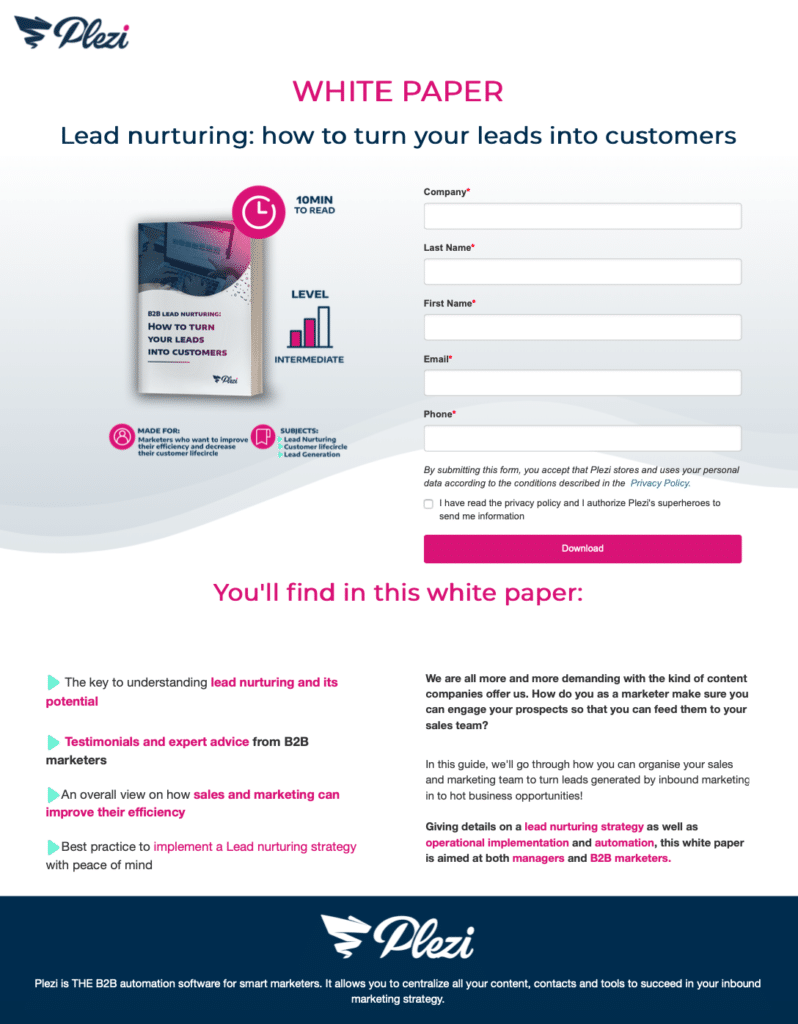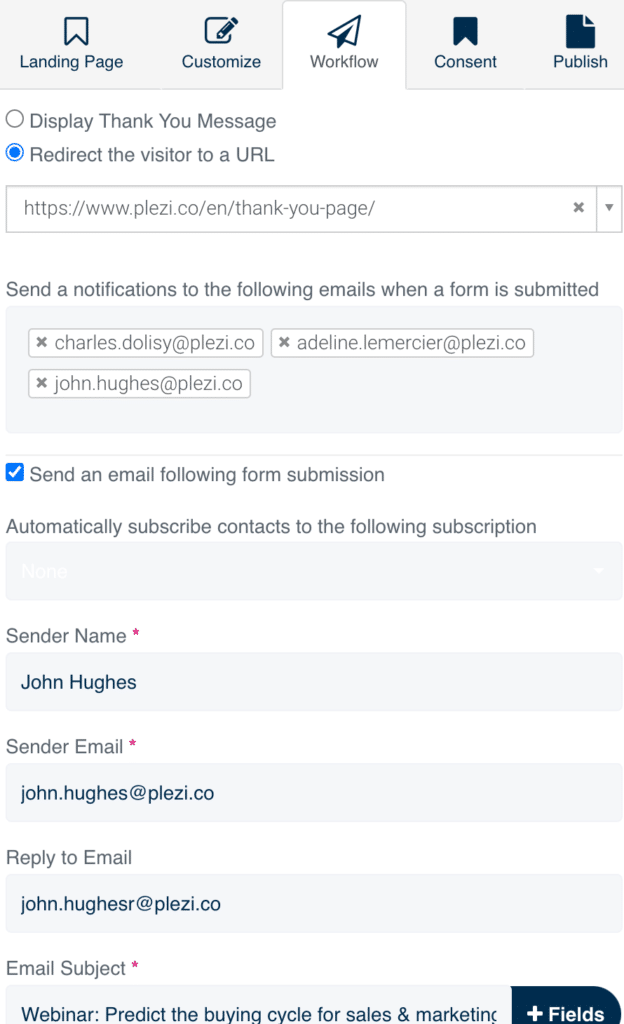The number one goal for content marketers is to generate leads. But there are at least two different types of content that marketers need to use to achieve that objective: content that attracts prospects to their website, and content that turns those prospects into a lead. This second type of content, specifically designed to appeal to potential customers, is called a “lead magnet” and is the beginning of your engagement with new business for your site.
1. What is a lead magnet?
A lead magnet is a piece of online content provided to prospects in exchange for their contact details. It is also known as “Gated Content” or “Premium Content.”
A typical example, that is also easy to put in place, is a blog post that can be downloaded in PDF format.
Lead magnets are a great way to gradually increase traffic to a website. But while blog posts are designed to increase inbound traffic, they won’t necessarily increase the number of leads. So, you’ll need to carefully monitor their conversion rate.
2. The different parts of a lead magnet
Each of the different terms used for this type of content can tell us something about how it works:
- “Lead magnet” indicates that it will attract leads, that is, convince visitors to voluntarily provide us with their contact details.
- “Gated content” indicates that it is not directly accessible.
- “Premium content” means that it is content with high added value, usually opposed to content that is freely available.
By definition, a lead magnet is a piece of content that can only be accessed after visitors fill out an online form.
It includes several different elements:
2.1 One or more calls to action
These are web banners, usually images, that promote content on your website. An example is this one that invites visitors to download our template for creating an editorial calendar:
2.2 A landing page
A landing page should make visitors want to provide us with their contact details in exchange for content. So, it needs to present that content in the best possible light. It should include:
- who the content is for (buyer personas)
- what pain point it addresses (value proposition)
- how it solves the given problem (content)
- what additional benefits it will offer prospects (ROI)
- elements designed to reassure prospects: e.g. a company description, a bio of the author, visuals.
2.3 A system for delivering content
There are 2 commonly used ways to deliver premium content to prospects:
- redirecting prospects to content: host content online and direct prospects to it once they’ve filled out an online form. This is the simplest solution but it’s also the riskiest, because even if someone enters an email address that isn’t valid, they’ll still be able to access the content.
- sending content by email: leads will receive either the content or a link that enables them to access it by email. This enables you to be even more sure of the quality of a lead and prevents dimwit@dimwit.com from downloading your content for free.
2.4 A lead scoring system
Most marketing automation software enables you to score leads according to the content they download. This makes it easy to manage calls to action, landing pages, your system for delivering content, and scoring.
3. The value of lead magnets
A “typical” B2B website converts around 2% of visitors into leads. If you have 1,000 visitors each month, that’s 20 leads. And if you have 10,000 visitors each month, that’s 200 leads.
If your conversion rate is 2% or less, converting visitors into leads by creating lead magnets should be your top priority. This will make your traffic acquisition strategy much more cost-effective.
Let’s look at an example of a successful lead conversion strategy. At Plezi, we created a large number of lead magnets in 2018. These enabled us to greatly increase our average conversion rate to 6.58% (Google Analytics statistics from April to December 2018).
For the same 10,000 website visitors each month, your number of leads would then increase to 658! This obviously gives you much more of an incentive to acquire more website traffic.
This figure is made possible by the high conversion rates that landing pages for pieces of premium content have, which increase the average conversion rate for a website significantly:
4. Different types of lead magnet
Lead magnets can take any one of a number of different forms. The key is that they deliver value to the audience they are designed to appeal to.
Lead magnets should address a specific topic or problem and not be too general, like a newsletter might be for example.
There are a number of different types of content that can act as lead magnets:
- White papers, eBooks, and reports provide detailed answers to specific issues faced by your target customers without trying to sell them anything.
- Checklists can support your target customers with step-by-step advice on how to solve a particular problem.
- Templates save your prospects time by providing them with something that they can make use of straight away (e.g. a schedule, budget, sample email).
- Quizzes or tests enable your target customers to assess their own situation.
- Kits help to resolve an operational problem.
- Access to an online video course or webinar.
5. How to create lead magnets that work
An effective lead magnet is first and foremost effective content. Lead magnets should therefore follow good practices for creating marketing content. But the difference between a lead magnet and a normal piece of online content lies mainly in that it tries to engage prospects to leave their details in order to access content.
A lead magnet must provide a specific solution to a defined problem. It will enable your prospects to either learn something, to save time, or both of these things.
5.1 Tailor lead magnets to a specific buyer persona
If you’ve implemented a content marketing strategy, you’ve probably already defined buyer personas that correspond to specific target customer profiles. In principle at least, each piece of content that you publish should be addressed to a specific persona.
This is even more true in the case of lead magnets. You don’t just need to attract more traffic to your website, you also need to generate qualified leads that are likely to turn into sales opportunities. And to generate qualified leads, you need to focus on a specific category of target customer. Then you should tailor your content to that particular target.
5.2 Address a specific problem
The best lead magnets are pieces of content that have the following features:
- They help prospects to overcome an obstacle, thereby contributing to their success
- They contain ideas that can be quickly put into practice
So, you should be constantly on the lookout for things which are a problem for your target audience. Because to be truly effective, lead magnets must address their pain points.
For example, we created our marketing persona kit, to help marketers create profiles for their target customers in a clearly defined way. Creating personas is the root of all marketing strategies, but many marketers are put off by doing it, due to the work involved, the time it takes and an impatience to get started on creating material and results. We tried to provide this handy template to take the pressure off and guide people through.
5.4 Protect your lead magnets
It can be difficult to protect content hosted either on WordPress or on another platform. This often involves adding code to the .htaccess file or adding security plugins.
It’s also important to ensure that the solution you use doesn’t allow content to be indexed by search engines. This would result in your content being freely available and probably causing the number of leads generated by this content to fall sharply.
To check if this is the case for your content, simply type into Google “site:yoursite.com filetype:pdf” and you should see a list of the PDFs that have been indexed on your website. All you need to do now is to check if there are any lead magnets in this list.
Do you want to turn visitors to your website into qualified leads without having to hypnotize them? Lead magnets are still the best way of going about this. By providing your visitors with content that has high added value in exchange for their contact details, you create a win-win situation. They get expert advice on the various problems they face, and you can place them into your marketing funnel. What lead magnets do you use to help you generate more leads?







